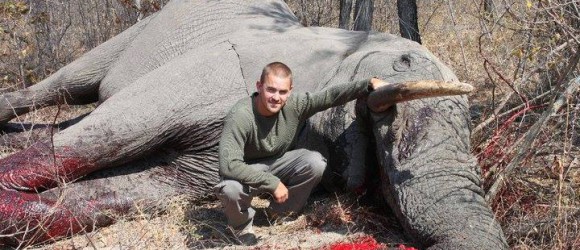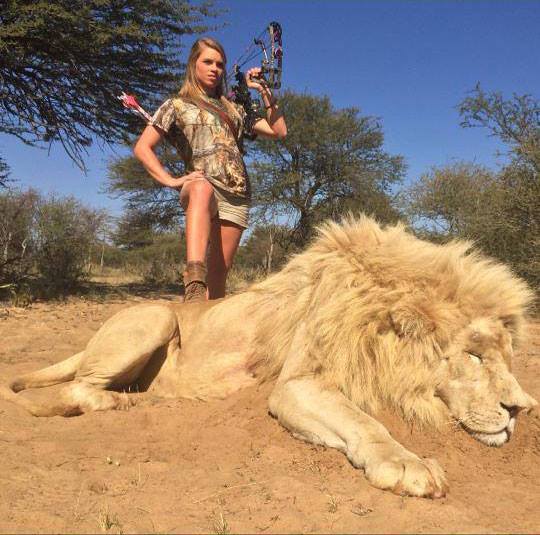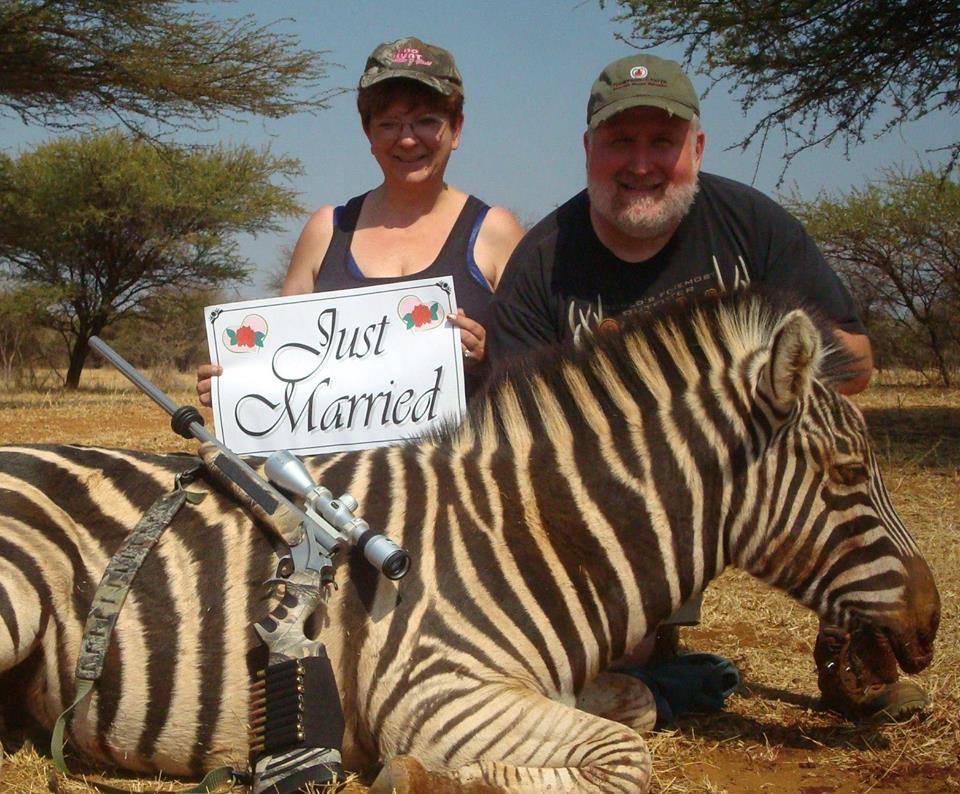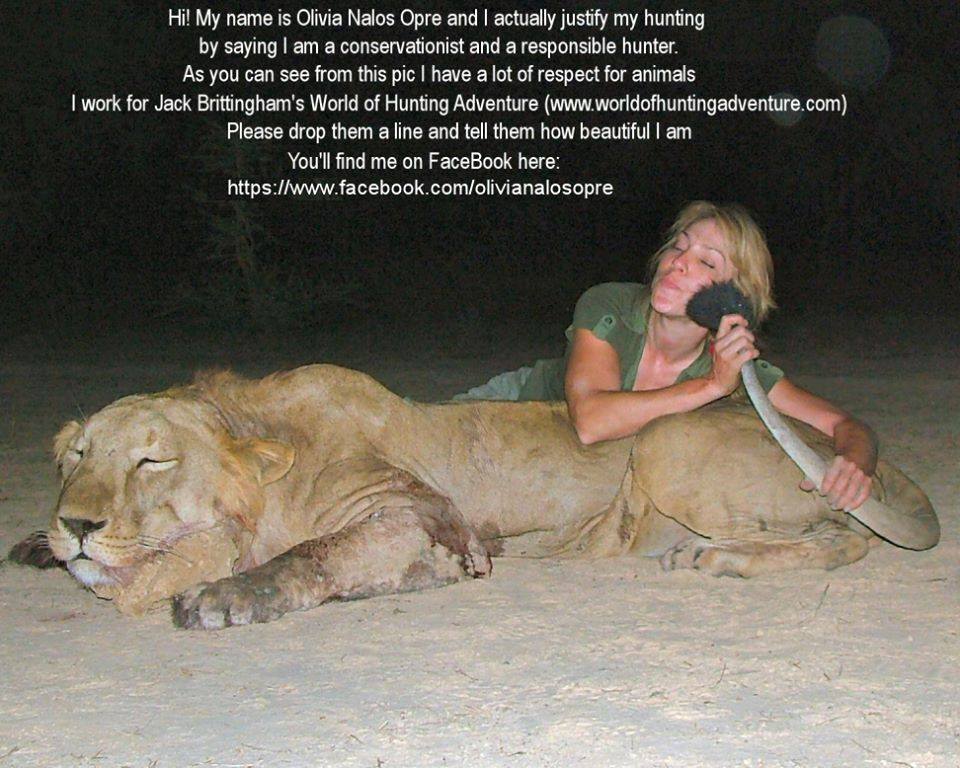Sport Hunting – Letter 3 From Chris Mercer
- At June 27, 2014
- By Rosemary Wright
- In Global Issues
 7
7

Sport Hunting – Letter 3 From Chris Mercer
Sport Hunting – Letter 3 From Chris Mercer – See below the reply from Chris Mercer to Johan Smit . The thread stared with Bradley Bergh’s letter to WWF concerning their support of trophy hunting. Thank you Chris for your response.
Bradley Bergh’s Letter To WWF
www.abeatingheart.ca/wwf-supports-sport-hunting/
Hunting is the kindest thing of all, says avid hunter Johan Smit, responding to Bradley Bergh’s excellent letter to WWF.
In his view, Texan huntress Kendall Jones pictured here, is being kind to the lion species.
By Chris Mercer
I have some comments to make on Mr. Smit’s condescending homily on the dubious benefits of the trophy hunting business. At the outset I should say that Mr Smit’s polemic is too rambling and inaccurate to be worth reading. All the ‘authorities’ he cites are spokesmen for the hunting industry itself. In other words he relies upon hunting propaganda rather than independent research.
If you want to read a more intelligent debate on the hunting issue, read the debate between former WWF man John Hanks and journalist Ian Michler.
http://showme.co.za/lifestyle/hunting-a-great-debate/
The farming issue is much broader than Smit allows. In the last two decades, employment of labour on SA farms has dropped catastrophically – the number of farms and of farmers has halved. There is a good summary on the plight of farmers by WWF here.
http://awsassets.wwf.org.za/downloads/facts_brochure_mockup_04_b.pdf
In that same period the number of game farmers has increased dramatically to more than ten thousand. Virtually all hunting in South Africa is canned hunting in that the hunts take place on private, fenced land where popular target species are bred for hunting as alternative livestock. So in such a developed mode, hunting in SA is a commercial farming operation that has nothing to do with conservation.
Smit confuses the issue by bringing in arguments based on community based resource management, which only apply to wild populations and true wilderness in Africa. In any event these CBRM projects like CAMPFIRE in Zimbabwe are proving to be unsustainable and self-defeating: see for example:
http://www.environmentmagazine.org/Archives/Back%20Issues/2011/July-August%202011/exploitation-or-conservation-full.html
This Concludes:
There are without a doubt economic and environmental benefits of hunting tourism, but these benefits go hand in hand with the threats of unsustainable quotas, poaching, corruption, and misconduct. CBNRM schemes have attempted to utilize the large revenues generated by hunting tourism to merge conservation and rural development. In theory, this is a far more effective conservation tool than the fences and fines approach; however, in practice; the win–win approach of CBNRM is proving to be more problematic.
Critics of sustainable development claim that the concept is contradictory, as economic growth and rural expansion will ultimately impede conservation aims, with the demands of an ever-increasing population causing irreversible damage to the environment. This certainly seems to be the case in relation to the hunting tourism industry. Only in rare, site-specific contexts have natural resources been managed in a manner that promotes social development while upholding conservation values.
In the context of Africa, social development and biodiversity conservation are two opposing forces – for one to prevail – the other must suffer.
1. Employment. Smit tries to persuade us that hunting is a great provider of employment.
“A typical game farm, according to Dry, employs three times as much staff as a comparable livestock farm, and pays three to four times more. Camera tourism in 5 star lodges only enriches the owners and shareholders. The majority of them being foreign companies, notorious for their meager salaries.”
Actually, the opposite is true – by a huge order of magnitude. See the Africa Geographic article ‘To Snap or Snipe’ by Ian Michler and the IUCN report that hunting is a poor employer and “a wasteful use of land”. In the same period that ‘game’ farms have grown to more than ten thousand, farm labour employment has fallen from one and a half million to about half a million – down by two-thirds.
2. Infrastructure. Smit alleges that hunting farms provide everything that a municipality provides. “Farms are similar to a municipality in very remote areas. It creates housing; it manages and supplies services like water, sewerage electricity, roads, clinics, schools and churches.”
How many churches have the trophy hunters built from the proceeds of cruel slaughter of wildlife, Mr. Smit? Not a very Christian way to fund a Christian church!
3. Hunting as culling? Smit confuses trophy hunting with the culling of surplus animals.
“The hunting equation is simple; animals breed and sooner or later their numbers have to be controlled to match the carrying capacity of a habitat as land is finite. If a landowner or community does the culling, they earn (much) less than hunters are prepared to pay for the privilege.”
But culling is a different proposition altogether – if there are too many animals in a limited area, then whole herds are removed in a para-military operation, to ensure the removal of the breeding females. Just shooting male trophy animals has nothing to do with culling – although it certainly harms the genetics of the species.
4. Trophy hunters show respect!!
“If a “trophy” is a reminder or a memento, even taking a picture should be wrong? If your problem is the death of the animal, then the following surely follows: Should a hunter utilize the meat and throw away or burn the horns and skin (the trophy), so as not to offend anyone, then he is wasteful and in a manner disrespectful of the animal.”
So Mr Smit contends that wasting a trophy would be “disrespectful of the animal”. Wow! No comment needed here.
5. Trophy photos not vain? According to Mr Smit, the photos of gloating hunters smirking away behind their dead victim is not vanity, but a practical tool required in order to get their firearms licence renewed.
“Current South African firearm laws dictate that dedicated hunters include proof of hunts in their firearm renewal application. The preferred proof is to include photos. Yes! Hunters smile on the photos, as it is enjoyable to be out in nature. A surly photo is also not going to convince the staff at the firearm registry that you have hunted the animal. This dispels the myth perpetuated by anti-hunting activists that all hunting photos are those of “trophy hunters”.
I can’t resist the urge to repeat this extraordinary statement:
“A surly photo is not going to convince the staff at the Firearms Registry that you have hunted the animal”.
Gee, I can see all the staff at the Firearms Registry hunched over the photos, examing them under a magnifying glass to see if the hunter is proud enough to be believed…
And here’s a thought: why post these trophy photos all over social media if they are for Registry staff eyes only? Hmmm…sorry Mr. Smit, I’ll stick to the crass vanity label.
6. Hunters and hypocrisy. Here is a novel argument: hunters ‘have peace of mind knowing that they did not outsource the killing’.
Hmm… so a serial killer (a hunter) feels good about himself because he commits his atrocities himself?
I get the hypocrisy of the meat eater who distances himself from the horrors of the abattoir, but why would a principal offender feel good about himself just because he was not a mere accessory after the fact?
7. Hunting videos are ‘not research’, he says. Look at any hunting video and it will sicken any compassionate person. Hunting is to conservation what pornography is to art.
Yet Mr. Smit pays no attention to these, because he contends that ‘they do not constitute research’. Well Mr. Smit, they certainly constitute evidence – and that is the important thing.
8. Hunters not in denial, says Mr Smit.
“Hunters do not live in denial. We are aware of land and feed being finite. We are aware of the effect of drought and we know that to hunt in order to preserve the species is the kindest cut of all. This illustrates the love we have for the animal. Also by enjoying the meat and celebrating its life while doing so!”
So hunters prove their love for animals by killing them, do they Mr. Smit? Because cruelty to one is a kindness to others of the species? There is crooked thinking for you! Lust for killing dressed up as love for animals.
9. The final question. Mr. Smit asks: “How are you going to sustainably manage wildlife in South Africa without compromising animal health and welfare.”
Mr. Smit cannot conceive of any paradigm of land use that does not include sport hunting. Well, Mr. Smit, we could throw the hunters off the land and absorb the hunting farms into expanded nature reserves, where predators could keep the prey animals numbers in check – naturally. Expanded eco-tourism in these new mega clusters would benefit the economy far more sustainably than hunting ever could.
Well Mr. Smit – I do believe that the volley is back to you! We all await your considered reply.




Follow – A BEATING HEART